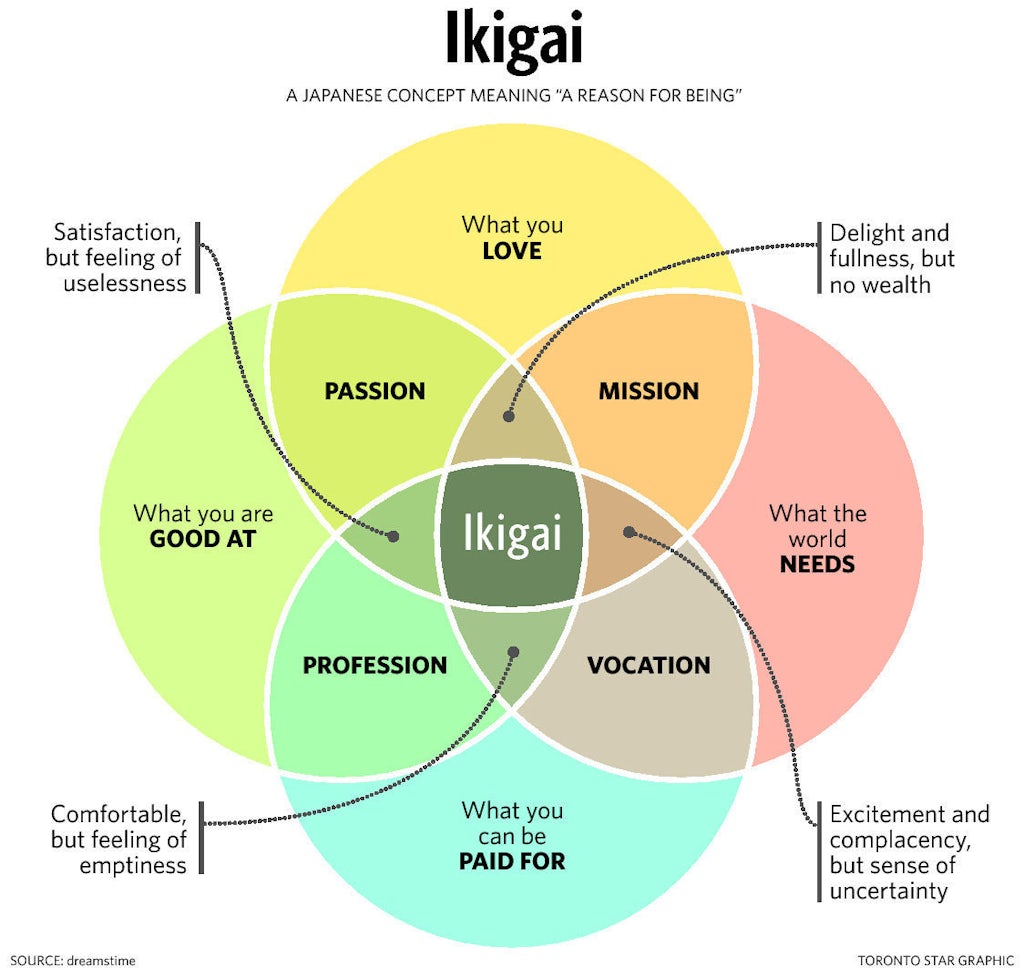Your vision and mission describe your dream. Your dream determines your commitment, your focus. Dream big, but make the steps towards your goal small and achievable. Your strategy defines short-term goals. Each goal presupposes certain actions. And these, in turn, need to be planned.
To set your goals, you need to know how you will measure “success”. Making art and being appreciated for it. Make space and time to do what you love and are good at. Using your artistic talents for a vision you believe in.
But sometimes these wishes conflict. You do what you are good at, but for an assignment (giver) that is not in line with your vision or values. You can show your work, but you can’t live off it. Or you jump from project to project, with no time for reflection.
How do you find a good balance between your objectives?
Finding a balance between those different components is possible with ‘ikigai’, a Japanese formula to – freely translated – ‘find the reason to get out of bed each day’. It consists of four components:
- What do you like?
- What are you good at?
- What does the world need?
- What can you get paid for?
Success is located at the intersection of your answers. Sustainable professionalisation means trying to earn money with your artistic talent, which makes a difference in the lives of others. Success lies at the intersection of all these components.
You may only be able to do what you love half-time, but rather do that than use your artistic talent full-time without recognition. Your professional life may be a patchwork of jobs and projects, but if they work together to give substance to your ‘ikigai’, it works. If you do this introspection regularly, you will find that you can make thoughtful choices artistically and non-artistically, personally and professionally.
And within this equilibrium you’ll discover goals.
What are good goals?
Good goals:
give structure, especially in a sector that can come across as a bit of a jungle.
- Example: You want to sell two works at a certain price during the first half of next year. That’s why you’re already talking to a number of galleries and curators. You ask them for advice and feedback about your work. Is it ready for sale? What following contacts should you make?
provide motivation
- Example: This year you want to be booked at least six times, one of which abroad. That’s why you prepare a list of warm contacts consisting of people who can help you further. Contact them, carefully prepare your promotional material.
help provide focus
- Example: By 2023 you want to be self-employed as a secondary occupation and earn 1000 euros per month with your art practice. That’s why you put your income and expenses on paper. You inform yourself by, for example, following a webinar on budgeting and bookkeeping. In collaboration with Cultuurloket, Flanders Arts Institute organises information sessions about the details and budget of your subsidy file.
Make sure you don’t try to do everything at once. Not every opportunity contributes to the plan and vision you have for yourself. Save your time and energy for what does.
- Example: If you need financial stability but you also want to start an ambitious artistic project, you may need to approach this in phases. First, save up to provide a buffer? Look for financing in the meantime? Put that nice offer to join another project on hold or let it pass you by?
- Your big dream is performing abroad. But how do you start? Maybe you can participate in exchange programmes? Come and discuss your international strategy with Flanders Arts Institute.




